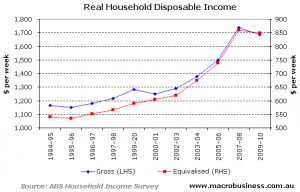What about my little country then: Australia? Well, a cursory glance at the graph (below) of real household disposable income, would suggest we're doing pretty well. Have a look, then I'll continue.
Well that one doesn't go back to the 70s, so here's one that does, but doesn't quite cover the little dip in the last few years:
There. Now there seems to be a reasonably steady trend upwards. That one is in '99/2000 prices.
However, commentators have argued that women's workplace participation has been a contributing factor to increasing income. Here is a graph showing the increase in workplace participation by gender. The bottom line is dotted (hard to see) and, as may be expected, represents women.
That's from here. The explanation notes that male participation has declined, but female participation has increased enough to make the overall participation rate increase, which has been extremely beneficial to the economy.
So, disposable income has about doubled in about the same time that womens' participation in the workforce has not quite doubled. Very well. Each of us must be better off. Right?
Well, here's another graph from the same document:
Married women's participation in the workforce is growing much faster than that of non married women. This means there has been a significantly greater increase in the proportion of people living together, married on dual incomes than data manipulators like The Australia Institute would claim. There isn't equivalent data available to show de facto arrangemnts, I'm afraid, or at least I can't find it right now. Young single people often live in share houses to lower costs. There isn't data on this, since the arrangements are often illegal (the landlords don't know) and share houses aren't regarded like families by gatherers of data like the ABS.
Either way, based on this cursory glance, it looks like we're not much better off than the 1970s. Right wing extremists like the 'Australia Institute' bewilderingly state, in rather sexist and patronising terms, that without women's participation in the workforce, average household disposable income would be higher. This is obviously misleading. There is a need here for more detailed analysis and also for concern. It quite clear that far more of us are working in order to achieve similar living standards to what we had in the 1970s. Whether those standards are in fact slightly higher or slightly lower though, that's something that needs to be investigated further. I'll look into it soon.



What about the fact that mining boom states are driving up wages in some states but the average for the rest of us is behing when compared to increased living expenses?
ReplyDeleteYes, that is a huge contributing factor. Thank you for bringing that up.
ReplyDeleteDo you think Australia is becoming a third world country and that the balance of power and wealth will shift worldwide? We export our resources (human and physical) to India and China and dispense with our manufacturing industries. It seems to me that an economy and society based on tourism, dog washing and haircutting is not sustainable. The mining boom is a good example of short-term greed at the cost of sustainability.
ReplyDeleteThank you for you comment. I have posted an extended, though probably inadequate response here: http://pinkyspage27.blogspot.com/2011/11/dog-washing-hair-dressing-and-future-of.html
ReplyDelete